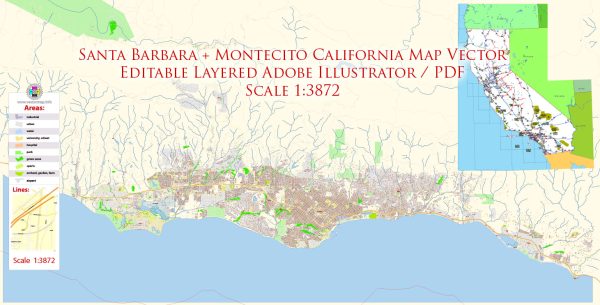Santa Barbara and Montecito, located in California, have a rich history of urban development that reflects the evolution of the region from its early indigenous inhabitants to its present-day status as a desirable and affluent community.
- Native Inhabitants: The area that is now Santa Barbara and Montecito was originally inhabited by the Chumash people, who established a thriving coastal culture. They lived in villages, engaged in fishing, and had a complex social structure. Evidence of their presence, including shell middens and artifacts, can still be found in the region.
- Spanish Colonial Period: Spanish explorers, including Juan Cabrillo and Sebastián Vizcaíno, arrived in the 16th and 17th centuries. In 1782, the Presidio of Santa Barbara was established as part of the Spanish colonization effort in California. The nearby Mission Santa Barbara, founded in 1786, played a crucial role in the cultural and economic development of the area.
- Mexican and American Periods: With the Mexican War of Independence in the early 19th century, California came under Mexican rule. However, after the Mexican-American War, California became part of the United States in 1848. The Gold Rush of 1849 brought increased migration and economic activity to the region.
- Rise of Agriculture and Industry: The late 19th and early 20th centuries saw the development of agriculture and industry in Santa Barbara and Montecito. Citrus orchards, vineyards, and olive groves flourished. The Southern Pacific Railroad’s arrival in 1887 further facilitated transportation and trade.
- Earthquake and Rebuilding: In 1925, a devastating earthquake struck Santa Barbara, resulting in significant damage. This event led to the implementation of strict architectural guidelines, shaping the city’s distinctive Spanish Colonial Revival style that is still evident in its buildings today.
- Post-World War II Growth: Following World War II, Santa Barbara experienced population growth and suburbanization. Montecito, known for its upscale estates and scenic beauty, became a favored residential area for affluent individuals. This period marked the beginning of a more modern and luxurious phase in the region’s urban development.
- Environmental Awareness: In the latter half of the 20th century, Santa Barbara gained prominence for its environmental activism. The 1969 oil spill off the coast raised awareness about environmental conservation, leading to the establishment of the Environmental Defense Center and inspiring the Earth Day movement.
- Contemporary Development and Challenges: In recent decades, Santa Barbara and Montecito have faced challenges related to urban planning, affordable housing, and preserving the area’s natural beauty. The region continues to attract tourists and residents alike, drawn to its Mediterranean climate, cultural attractions, and high quality of life.
Overall, the history of urban development in Santa Barbara and Montecito reflects the convergence of indigenous heritage, Spanish colonization, economic booms, architectural styles, and a commitment to environmental preservation. Today, the region stands as a testament to the interplay between history, culture, and a dynamic urban landscape.


 Author: Kirill Shrayber, Ph.D.
Author: Kirill Shrayber, Ph.D.